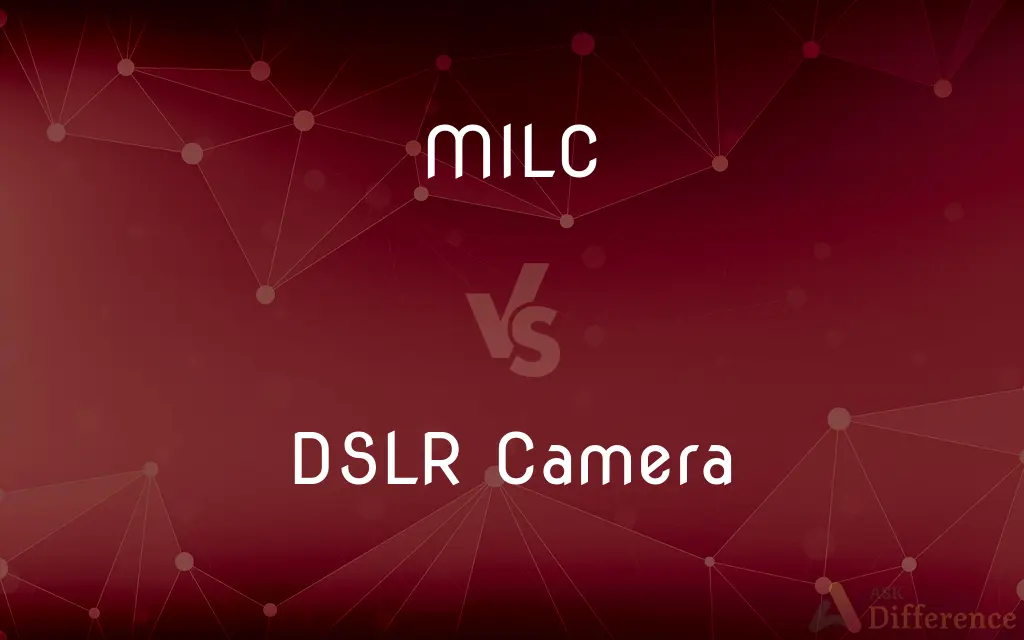MILC vs. DSLR Camera — What's the Difference?
By Tayyaba Rehman & Maham Liaqat — Published on February 19, 2024
MILC (Mirrorless Interchangeable Lens Camera) lacks a reflex mirror, making it compact. DSLR (Digital Single-Lens Reflex) uses a mirror mechanism for viewing and shooting.

Difference Between MILC and DSLR Camera
Table of Contents
ADVERTISEMENT
Key Differences
MILC (Mirrorless Interchangeable Lens Camera) and DSLR (Digital Single-Lens Reflex Camera) are two categories of cameras that represent different approaches to digital photography. MILCs, as the name suggests, do not have a reflex mirror system, which is a key component of DSLRs. This absence allows MILCs to be more compact and lighter than DSLRs, offering a more portable solution for photographers. MILCs use electronic viewfinders (EVF) or simply the digital screen on the back for framing and capturing images, allowing for a real-time digital preview of the scene.
DSLR cameras, on the other hand, utilize a reflex mirror mechanism that directs light from the lens to an optical viewfinder, allowing the photographer to see exactly what the lens is capturing. When the shutter button is pressed, the mirror flips up, the shutter opens, and the light hits the image sensor, capturing the photo. This system has been the standard for professional and serious amateur photography for decades, offering robust build quality, optical precision, and a wide range of lenses and accessories.
One of the main differences between the two types of cameras lies in their viewfinding systems: MILCs rely on electronic previews, which can consume more battery power but offer advanced features like focus peaking and real-time exposure simulation. DSLRs offer an optical view through the lens that many photographers find more natural and immediate, especially in fast-moving situations, although they tend to be bulkier due to the mirror box and prism system.
In terms of performance, MILCs have closed the gap on DSLRs, offering comparable image quality, fast autofocus systems, and high-resolution video capabilities, often in a smaller package. DSLRs still hold advantages in battery life and optical viewfinder performance under certain conditions, such as low light or fast action.
Choosing between a MILC and a DSLR often comes down to personal preference, intended use, and priorities such as size, weight, battery life, and specific features like autofocus speed or video capability. Both systems have matured, with extensive lens and accessory ecosystems, making them capable tools for a wide range of photographic endeavors.
ADVERTISEMENT
Comparison Chart
Viewfinder
Electronic (EVF) or digital screen
Optical through a reflex mirror system
Size and Weight
Generally more compact and lighter
Larger and heavier due to mirror mechanism
Autofocus System
Fast and accurate, uses on-sensor AF points
Uses separate phase-detection AF module
Battery Life
Shorter due to continuous sensor and screen usage
Longer, as optical viewfinder consumes less power
Image Preview
Real-time digital preview with exposure simulation
Direct optical view, no real-time digital preview
Compare with Definitions
MILC
Uses electronic viewfinders for image composition.
The EVF on my MILC makes it easy to preview exposure changes.
DSLR Camera
Offers robust build and ergonomics.
DSLRs are durable and designed for comfortable handling during long shoots.
MILC
Cameras without a reflex mirror system.
I prefer MILC for travel due to its lightweight design.
DSLR Camera
Known for long battery life.
I can shoot all day on a single battery charge with my DSLR.
MILC
Known for compactness and portability.
MILCs have revolutionized street photography with their unobtrusive size.
DSLR Camera
Features separate autofocus module.
The phase-detection autofocus in DSLRs is incredibly fast and accurate.
MILC
Offers advanced video features.
My MILC shoots 4K video, making it perfect for filmmaking on the go.
DSLR Camera
Utilizes a mirror and prism system for viewing.
The optical viewfinder on a DSLR gives a clear, lag-free image preview.
MILC
Quick autofocus with on-sensor points.
The autofocus on MILCs is great for capturing fast-moving subjects.
DSLR Camera
Preferred for extensive lens and accessory options.
My DSLR system allows me to use a wide range of lenses for different shots.
Common Curiosities
Can MILCs match DSLRs in image quality?
Yes, modern MILCs offer comparable image quality to DSLRs.
What does MILC stand for?
Mirrorless Interchangeable Lens Camera.
How does a DSLR camera work?
It uses a reflex mirror system to direct light to an optical viewfinder.
Why are MILCs considered more portable?
They lack the bulky mirror mechanism of DSLRs, making them lighter and smaller.
Do DSLRs have better battery life than MILCs?
Generally, yes, due to the lower power consumption of optical viewfinders.
Which is better for beginners, MILC or DSLR?
Depends on the user’s preference for size, viewfinder type, and battery life.
Can MILCs use DSLR lenses?
Yes, with adapters, but functionality might be limited.
Are lenses interchangeable between MILCs and DSLRs?
Yes, with proper adapters, but native compatibility varies by brand and model.
Which type is more durable, MILC or DSLR?
DSLRs are often built more ruggedly, but many MILCs are also designed for durability.
How do MILCs handle low light compared to DSLRs?
Modern MILCs perform well in low light, comparable to DSLRs, partly due to their EVFs.
Why do some professionals still prefer DSLRs?
For their optical viewfinder clarity, battery life, and extensive lens ecosystem.
Why might a photographer prefer a DSLR's optical viewfinder?
For its natural view, especially in bright light or fast-action scenarios.
Are MILCs good for video?
Yes, they often have advanced video features superior to many DSLRs.
Is there a significant price difference between MILCs and DSLRs?
Prices vary widely, with both types offering options from entry-level to professional.
Do MILCs have a faster autofocus than DSLRs?
In many cases, yes, due to the use of on-sensor phase detection points.
Share Your Discovery

Previous Comparison
Sharara vs. Lehenga
Next Comparison
Hilum vs. Root of LungAuthor Spotlight
Written by
Tayyaba RehmanTayyaba Rehman is a distinguished writer, currently serving as a primary contributor to askdifference.com. As a researcher in semantics and etymology, Tayyaba's passion for the complexity of languages and their distinctions has found a perfect home on the platform. Tayyaba delves into the intricacies of language, distinguishing between commonly confused words and phrases, thereby providing clarity for readers worldwide.
Co-written by
Maham Liaqat













































